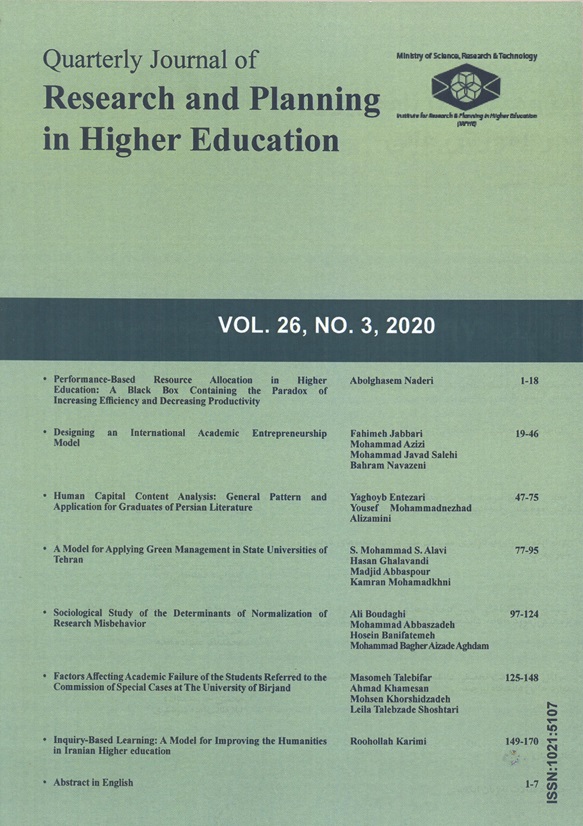A Model for Applying Green Management in State Universities of Tehran
Authors
1 Professor, Department of School Engineering, Sharif University of Technology, Tehran, Iran.
2 Associate Professor, Department of Management and Economics, Islamic Azad University, Science and Research Branch, Tehran, Iran.
Abstract
In recent decades, human beings have been well aware of the dangers of neglecting the environment. Today, environmental and sustainable development concerns stand among the most important issues in the international community. Universities need green management to reduce the consumption of resources, materials, energy, and organizational costs, help reduce environmental pollution, nurture green thinking, and culture. Therefore, this study aimed to provide a model for applying green management in state universities in Tehran. The present study was applied, which was carried out through a survey method among 395 faculty members, managers, and staff of 10 state universities in Tehran. The method was mixed in terms of approach. Employing Delphi and the consensus of 19 experts in the field of higher education, environment, and living environmental management, the dimensions and components were then approved. A researcher-made questionnaire collected the required data. Inferential statistics such as t-test and structural equation modeling using the PLS method were used for data analysis. Technology, policymaking, governance, leadership and strategy, material resources, and financial resources are more important in deploying green management than human resources, monitoring, evaluation, environmental communication, information resources, education, and research.
Keywords
2. Arasteh, H., & Amiri, E. (2012). The role of universities in sustainable development education. Journal of Nasha Alam, 2(2) (in Persian).
3. Clark, W.C., & Dickson, N.M. (2011). Sustainability science: The emerging research paradigm. the National Academy of Science of the United States of America, 100 (14), pp. 8059-8061.
4. Ghorchiyn, N. (2004). University as a model for sustainable development; New paradigm. Higher Education and Sustainable Development (p. 230). Tehran: Institute of Higher Education Research and Planning (in Persian).
5. Hur, T., Ik, K., & Yamamoto, R. (2004). Measurement of green productivity and its improvement. Journal of Cleaner Production, 12(7), 673-683.
6. Kah Hoe, Y. (2011). Achieving sustainable campus in Malaysia University (Master's thesis). University Technology Malaysia.
7. Kicherer, A. (2002). The BASFE efficiency Method Sustainable Decision Tool. Proceedings of the 5th International Conference on Eco balance. Tsukuba, Japan.
8. Lee, S. (2007). Innovation of higher education for sustainable development. 11th UNESCO-APEID International Conference Reinventing Higher Education: Towards Participatory and Sustainable Development. Retrieved from http://www.unescobkk.org/education/ apeid/apeid-international-conference/11apeidconf/speakers-and-speeches/samuel-lee/innovation-in-higher-education-for-sustainable-development.
9. Ling Woo, Y., Mokhtar, M., Komoo, I., & Azman, N. (2012). Education for sustainable development: A review of characteristics of sustainability curriculum. OIDA International Journal of Sustainable Development, 3(8), 33-44. Retrieved from https://papers.ssrn.com/sol3/papers. cfm?abstract_id=2031102.
10. Malekinia, E. (2014). Designing a model for evaluation of sustainable university: Case study University of Tehran (Doctoral dissertation). Tehran: University of Tehran (in Persian).
11. McIntosh, M., Cacciola, K., Clermont, S., & Keniry, J. (2010). State of the campus environment: A national report card on environmental performance and sustainability in higher education. The National Wildlife Federation, State of the Campus Environment. Princeton Survey Research Associates. Retrieved from https://www.nwf.org/EcoLeaders/ Campus-Ecology-Resource-Center/Reports/State-of-the-Campus-Environment.
12. Mohsenin, S., & Sfidani, M. (2014). Structural equations based on partial least squares using smart-PLS software (educational and practical). Tehran: Mehrban Nashr.
13. Sadeghi, M. (2013). Developing a model for sustainable university in Islamic Azad University (Doctoral dissertation). Tehran: Islamic Azad University, Science and Research Branch (in Persian).
14. Savely, S.M., Carson, A.I., & Delc, G.L. (2007). An environmental management system implementation model for U.S. colleges and universities. Journal of Cleaner Production (15).
15. Shakrchizadeh, M. (2017, December). The amount of energy consumption in Iran is three times that of similar countries (in Persian).
16. Stewart, M. (2010). Transforming higher education: A practical plan for integrating sustainability education into the student experience. Journal of Sustainability Education, 1(5), 1-13.
17. Vinzi, E.V., Chin, W.W., Henseler, J., & Wang, H. (2010). Handbook of partial least squares. Berlin: Springer.
18. Waas, T., Hugé, J., Ceulemans, K., Lambrechts, W., Vandenabeele, J., Lozano, R., & Wright, T. (2012). Sustainable higher education. understanding and moving forward. Brussels: Flemish Government – Environment, Nature and Energy Department. Retrieved from https://limo.libis.be/:https://limo.libis.be/primo-xplore/fulldisplay?docid =LIRIAS1679848&context=L&vid=Lirias&search_scope=Lirias&tab=default_tab&lang=en_US&fromSitemap=1
 Quarterly Journal of Research and Planning in Higher Education
Quarterly Journal of Research and Planning in Higher Education
